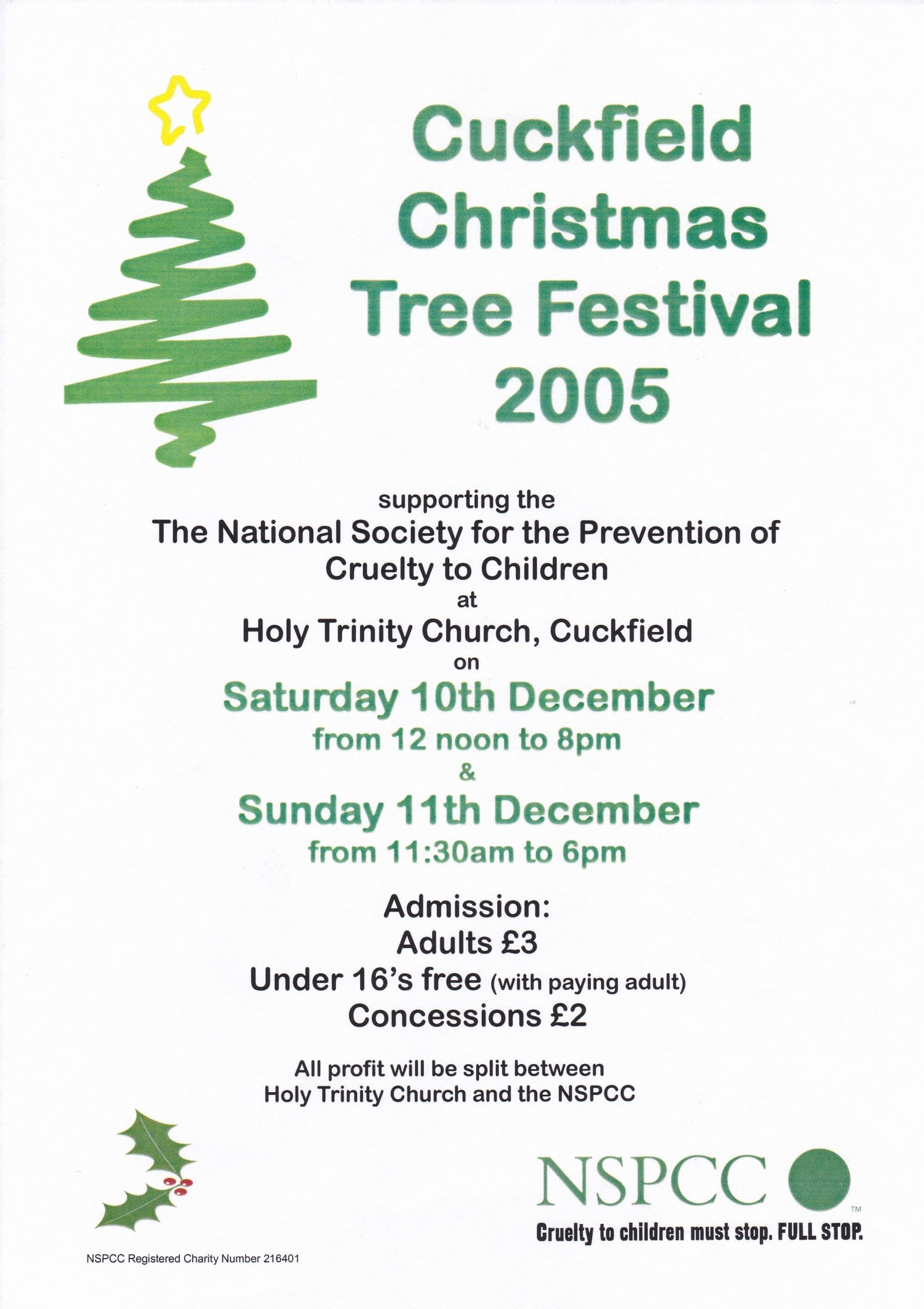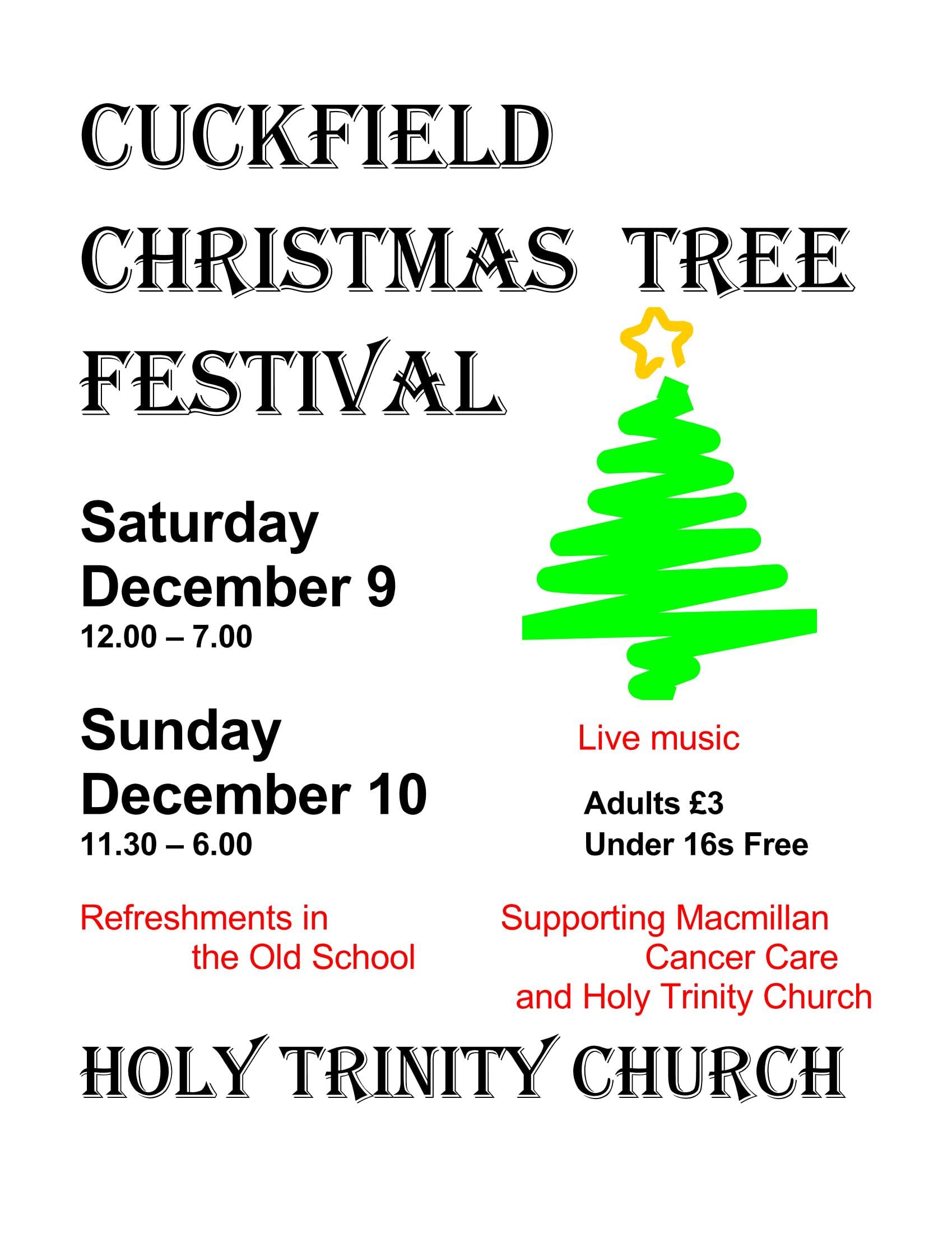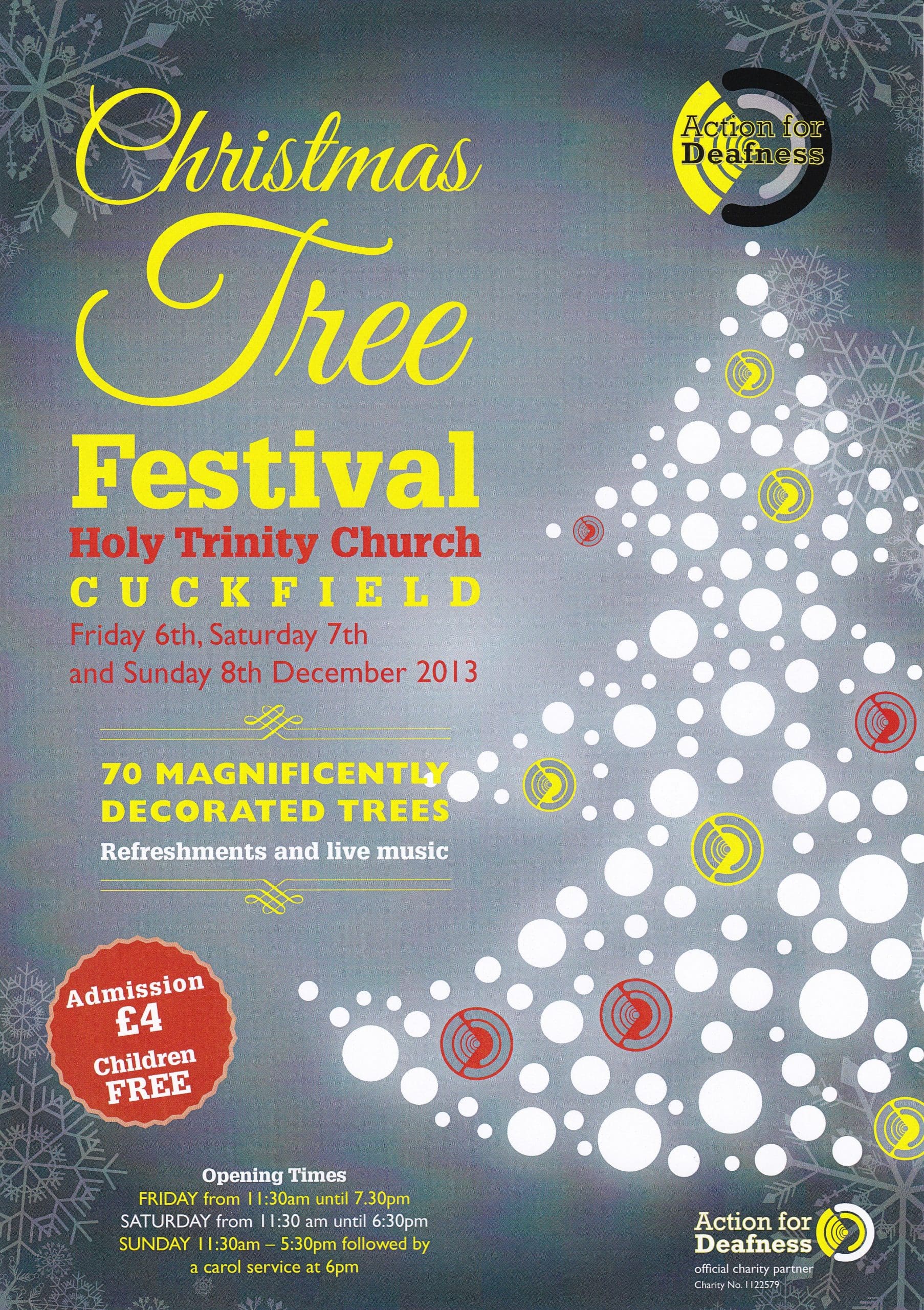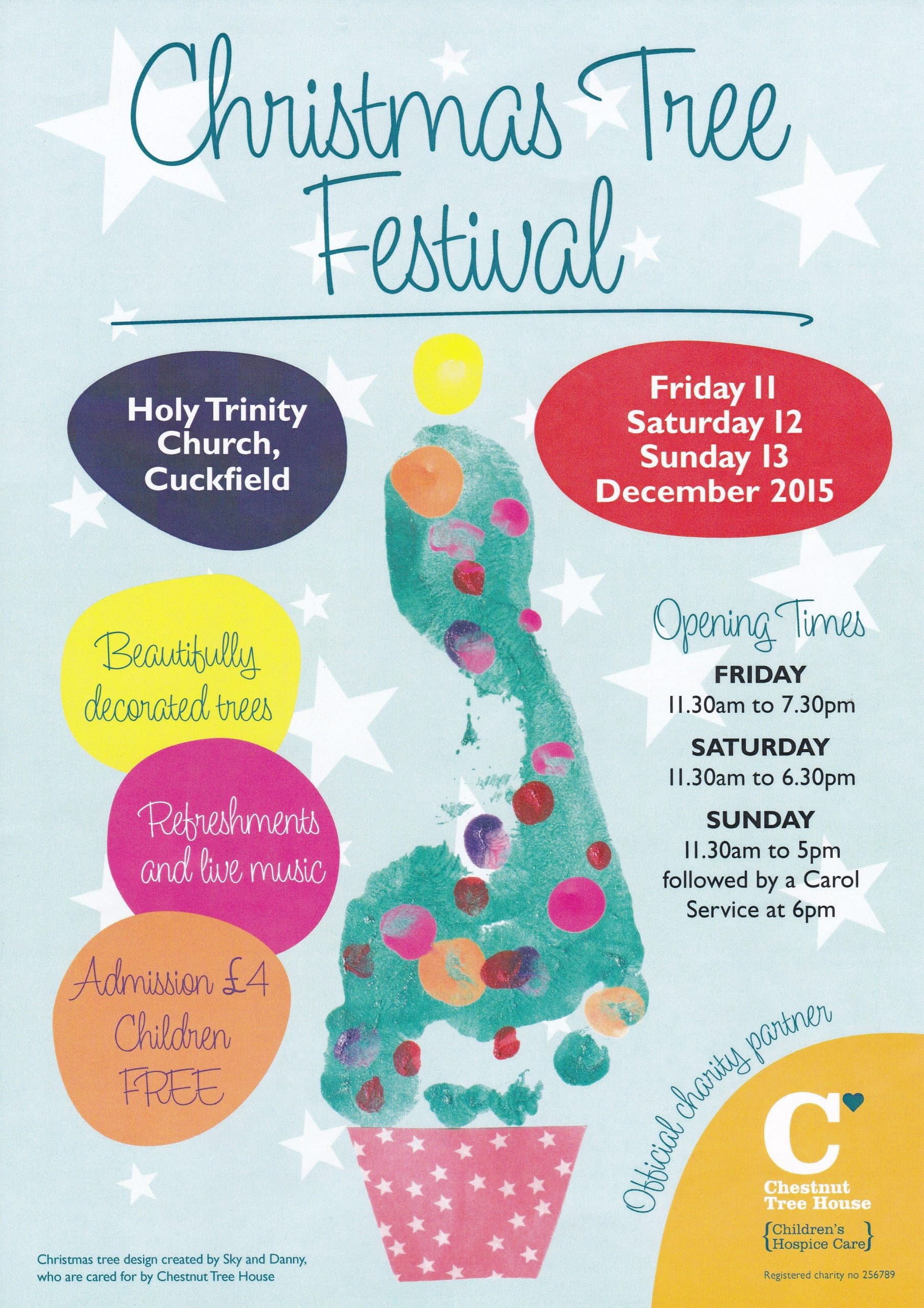
The first festival was held in 2003. It was a tremendous success and is now held annually due to popular demand! To date we have raised £95,577 for charity.
In the beginning
Back in the late 1990s the Reverend Jean Sedgley had a telephone call from a colleague who had moved to a parish in Hertfordshire. ‘They do something very strange here’, said her caller. People brought their own Christmas trees – any size, real or artificial – to the church and decorated them how they liked. Families, individuals and groups joined in; other people came in to view the trees and to judge the best tree.
Fast-forward to early 2003 when clergy in Chichester Diocese went to a conference and heard the Bishop of Horsham give an address on the importance of using Advent as a time when parishes should engage with their communities. Local churches are often key to celebrations in December and clergy were encouraged to take this opportunity to keep people in touch with the church. This would also be a good time for the church to support organisations in the locality.
The Reverend Nick Wetherall and Jean had a meeting to discuss the conference. ‘What shall we do?’ asked Nick. Jean remembered the parish in Hertfordshire and their competitive Christmas trees and suggested that this idea could be adopted but developed in such a way as to suit Cuckfield.
A committee was formed and the key elements were quickly agreed:
- real trees would be provided;
- instead of being a competition it would be a celebration of Christmas suitable for everyone – a ‘Festival’;
- organisations would be invited to sponsor a tree each and to decorate it as they chose, including the installation of lights, which would give them the opportunity to promote themselves to a wider audience;
- financial support would be given to a chosen charity for the year, in addition to funds being raised for the church, initially just to cover expenses.
A presentation was given to the Parochial Church Council to explain the aims of the Festival, to gain their permission and to ask for a loan of £200 for expenses. Permission was given but, instead of a loan, a grant of £200 was offered which would not need to be repaid should the project fail. The grant was never needed – the Festival was ‘in profit’ before it even opened!
Problem Solving and Preparations
One of the first things to be done was to estimate how many trees would fit into Holy Trinity Church. Inspiration came from a child’s hula hoop: this was taken around the building, laid in any spare space and a rough count of 60 trees was agreed upon.
Having set out these parameters the problems quickly hove into view: how do you support the trees? How do you place the trees within the church bearing in mind that at that time fixed pews constituted the seating? How do you get an electrical supply to each tree?
At the beginning of the planning stage, the overriding driving force was that costs had to be kept to an absolute minimum since this could well be just a ‘one-off’ event. Tree stands could be bought but the cost would be prohibitive. Brian Brown was asked to come up with a tree stand design and, after several prototypes, he developed the current model, which has certainly stood the test of time. A key aspect of the design was how to make the box section accommodate the bottom of the tree? To answer this question several committee members spent time measuring the circumference of loads of Christmas trees, at ground level, in a field on the Balcombe Estate, the initial provider of the trees.
The next problem was obtaining the wood to be used to make the stands. Initially, any skip outside a house where development was taking place was scoured for off-cuts of timber. It quickly became obvious that this was not a source which would enable very many stands to be made. At this time the Bolnore Estate was under construction and a kindly site manager agreed that we could have as much gash timber as we wanted, the source being rough wood that had been used to protect stacks of floorboard planks. So, having a design and raw materials a group of amateur carpenters helped Brian to manufacture the stands in his workshop.
Pieces of old carpet underlay were to be used to protect the pew from damage when a stand was placed on it but how to keep the tree from falling over? The solution was to use old tights to strap the tree and stand in position. So, after a morning service, the cry went out ‘give us your tights!’
In order to get power to each tree extension leads were needed to criss-cross the floor from the limited number of sockets in the building. Again it was felt that, for cost reasons, new leads could not be justified. So, again after morning service, a cry went out ‘lend us your leads!’
And both pleas were successful – tights and leads were forthcoming in abundance.
The re-ordering project within the church, completed in 2012 – including the removal of the pews – has enabled the trees to be positioned on the floor, which has greatly simplified the tree installation work and has provided space for more trees.
At first parishioners were slow to sign up to help with all the different areas of organisation – setting up and clearing up, stewards, refreshments and on the door – but in subsequent years this became less of a problem: people liked to be associated with something that had proved to be a success.
The First Festival: December 2003
So, after much hard work, the first Festival was ready to open with some 60-plus trees on display. The Rt. Revd. Lindsay Irwin, Bishop of Horsham, was invited to come and open the Festival, which he duly did. However, for some reason, this turned out to be a once and for all experience! It was a wet and dreary Saturday morning and by lunchtime few people had ventured to the church. Fear: ‘the village won’t support us’.
The weather improved and so did the number of visitors and all were delighted with the magical view of the lit trees and the imaginative talent displayed by the tree sponsors in their tree decoration efforts.
It was felt by the organisers that the Festival should offer something more than simply a tour of Christmas trees, however beautifully decorated, so additional attractions were introduced to enhance the experience.
First, a programme of live music was planned to last throughout the Festival, with a very wide variety of musicians providing background entertainment and also, of course, giving them an opportunity to ‘showcase’ their talents. This was so successful that it has continued through every Festival to the present day.
To start with, Christmas music was fed through the sound system by CDs. Live music was introduced initially by the church choir and Holy Trinity musicians. Community groups were then added and these included schools, local choirs and instrumental groups. What has developed over the years is a three-day live music festival running alongside the main Festival.
Secondly, the Festival Café was opened, run by a group of volunteers, to provide light refreshments for visitors, with the extra facility of a special area given over to Christmas activities for children, organised by Children’s Church. It is a pleasure to see extended families coming together for lunch and sociable time.
And then, in the Church, to complement the ‘real’ trees, a dedicated group of ladies decorated small artificial Christmas trees on every windowsill, on the pulpit and in the North porch, which they have continued to do ever since.
Decorating individual trees has become almost an art form. One club began by going into a member’s loft for her family’s Christmas decorations. Other groups caught on quickly and realised that to catch attention for their project then a theme had to be developed. The District Council produced a tree covered in mini recycling bins, the Alzheimer’s Society one covered in a tangled web of muddled dementia-like connections and the year the Cuckfield Museum was burgled one half of their tree was stripped bare.
The first Festival concluded with the customary Sunday Service of Evensong; it was felt, it must be said, that this was something of an anti-climax, and so a traditional Carol Service was substituted, enjoyed and appreciated by many hundreds of people over the years, with the added attraction of mulled wine and mince pies at its close.
The charity chosen for the first Festival was St. Peter & St. James Hospice at North Chailey. They were delighted to receive over £1,500, this being part of £3,000 which was raised during the weekend.
The success of the event was due to a huge effort by many people and in the aftermath, there was a body of opinion which felt that due to the workload the Festival should only be held every other year. A number of people canvassed against this idea on the basis that, if there was a fallow year, then, capitalising on the Festival’s success, another local church could take it up and it would be lost to Holy Trinity in the future. Fortunately, the yearly view prevailed.
Advertising and Promotion
Advertising always plays a key part in organising any major event and a variety of different ways have been adopted in promoting the Festival. There have been mentions and interviews on local radio stations, with articles appearing in newspapers and magazines in the community. Giant banners on roads and roundabouts and ‘For Sale’ boards have played their part. One of the innovations which the organising committee instigated was to invite a local estate agent to have the Festival details displayed on its boards outside village properties. This was one of the earliest occasions for this activity which has now become such a widespread method of advertising events. Perhaps not surprisingly, one householder received a number of enquiries regarding the possible purchase of their house!
And, of course, keeping up with the electronic times, there is this attractive and much-visited website www.cuckfieldctf.org.uk together with an annual entry on Facebook.
But the most colourful and eye-catching advert has to be the Festival poster. Initially, this was produced ‘in-house’ but in 2007 the Children’s Society, the chosen charity for that year, offered to design and produce the poster. Since then each charity has been invited – and has always been happy – to do the same, with some wonderful results, most of which can be viewed below.
Nevertheless, probably the most successful way of bringing in visitors has to be ‘word of mouth’. There is no substitute, however sophisticated other means may be, for people telling others that ‘they must visit the Cuckfield Christmas Tree Festival’.
Profit-sharing
Although the main aim of the Festival has not just been to raise money but to engage with the community, nevertheless over the years it has developed into a major fundraiser: since 2003 in excess of £150,000 has been raised. In the beginning, it was agreed to divide all profits equally between the Church and the year’s chosen charity, with that charity also benefiting from specific donations. Consequently, the Festival now provides a very welcome injection of revenue for both Church and Charity. Below is the charitable donation history:
| Year | Charity | Amount Raised | Poster |
| 2003 | St Peter & St James Hospice | £1,500 | no poster |
| 2004 | Sightsavers | £2,400 | no poster |
| 2005 | NSPCC | £3,100 |  |
| 2006 | Macmillan Cancer Support | £4,100 |  |
| 2007 | The Children’s Society | £4,175 |  |
| 2008 | St Catherine’s Hospice | £4,511 |  |
| 2009 | Leukemia Research Fund | £4,796 |  |
| 2010 | Downs Syndrome Association | £4,690 |  |
| 2011 | Help for Heroes | £5,000 |  |
| 2012 | HemiHelp | £4,260 |  |
| 2013 | Action for Deafness | £5,800 |  |
| 2014 | Kent, Surrey & Sussex Air Ambulance | £5,241 |  |
| 2015 | Chestnut Tree House Children’s Hospice | £6,461 |  |
| 2016 | Mid Sussex Branch of Parkinson’s UK | £7,115 |  |
| 2017 | Chailey Heritage | £7,037 |  |
| 2018 | Kangaroos | £6,700 |  |
| 2019 | Alzheimer’s Society | £7,272 |  |
| 2020 | Event cancelled because of the Coronavirus pandemic | — | — |
| 2021 | Event cancelled because of the Coronavirus pandemic | — | — |
| 2022 | Golden Lion Children’s Trust | £6,876 |  |
| 2023 | Stroke Association – Cuckfield Support Group | £6,125 |  |
What could possibly go wrong?
In organising any major event there is always the risk – and indeed the scope – for things to go not according to plan. Thankfully, to date – and hopefully this is not tempting fate – everything has generally worked out with just a few technical hitches, meaning that, at the end of every Festival, the Planning Group has been able to heave a collective sigh of relief. However, that is not to say that there have not been a few issues to resolve.
On one occasion a gazebo, erected to shelter the west door entrance, took off overnight in a high wind and was found the next morning draped over the north porch, fortunately causing minimal damage to the church building, but regrettably writing itself off in the process.
And then there was the afternoon of torrential rain featuring a herd of cows and three trouble-making youths … the former invading the churchyard and causing havoc among the gravestones and the latter bent on making mischief in the Festival Café – both at the same time. Fortunately, neither spoilt the enjoyment of the visitors.
Of greater concern, in 2005 the militant activists ‘Fathers for Justice’ were targeting the NSPCC, which was the chosen charity for that year; it was feared that there might be a potential threat of disruption, perhaps remote, for the Festival, but, thankfully, it did not materialise.
And today, in the current climate of possible terrorist threats at large events – yes! – even in Cuckfield – the Festival has to be integrated in to the Terrorist Risk Assessment required by the Police from the Parish Council in its organisation of the Village Street Festival, with very detailed plans for evacuation … not so far implemented and long may it remain so.
What of the future?
Since 2003, the Festival has never failed to attract sponsors to fill the Church with trees and many thousands of visitors come and enjoy the spectacle. For many, it is ‘the start of Christmas’ and a focus for family and friends uniting.
It has become a firm fixture not only in the Church but also in the Village. For many years the Festival has been an integral part of the Cuckfield Village Street Festival.
It was agreed at the outset that if either the number of sponsors or the footfall through the doors significantly reduced, then the Festival would have had its day; so far neither shows any sign of happening.
It must by now be regarded as a tradition – one which will, hopefully, continue for many years to come, at any rate for so long as there are people able and willing to organise it, a small army of volunteers to support it and people to come and enjoy it.

